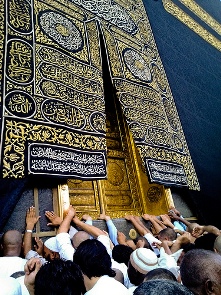Millions of Muslims prepare for Hajj 2009

During Hajj, millions of pilgrims circle a structure built by Abraham, known as Kaaba. Here, pilgrims touch the entrance to Kaaba in reverence. It is believed that, just as atoms circle around a nucleus and the Earth rotates around the sun, so pilgrims circle around Kaaba.
Photo courtesy of Omar Chatriwala
So vital is this journey that it is known as “Hajj,” one of the Five Pillars of Islam. According to the Islamic tradition, every Muslim - as long as he is in good health and is financially able - is obligated to take this pilgrimage at least once in a lifetime. Although the date of Hajj changes from year to year on the Gregorian calendar, the rituals are performed each year on the 8th-12th days of the Islamic month Dhu al-Hijah (“the month of the Hajj”). On Wednesday, millions of Muslims will begin Hajj 2009.
“The historical basis of the pilgrimage is based on the rites of the Prophet Abraham,” said Abdul-Jaleel, a Muslim from Ann Arbor who has completed Hajj three times. “It’s based on the rites he learned from God.”
According to the Quran, Abraham built this “House of God,” also know as “Ka’bah” or “Kaaba” (spellings vary), when God instructed him to build in the desert. Today, a mosque surrounds the Kaaba, and during Hajj (numbers vary each year), between 2 and 8 million Muslims circle this structure in prayer.
“It’s almost surreal; you ask, ‘Am I really here? Are there really that many people here?’” said Abdul-Jaleel. “How would you feel? It brings me to tears, because no one is there for any other purpose than to pray and to do something right.”
While hailing from countries at war, speaking different languages and being a part of vastly different cultures, believers will pray together, shoulder-to-shoulder, and sleep next to one another. (Muslim Victor Begg recently wrote his firsthand account of Hajj, published on ReadTheSpirit.) Each pilgrim hopes that his or her pilgrimage will be accepted by God, because if a Muslim succeeds, Abraham and Muhammad taught that he or she will have sins erased.
How does one know if his or her pilgrimage was accepted?
“We’re taught that when you return from the pilgrimage, you have a spiritual upliftment,” explains Abdul-Jaleel. “I think it’s like if you see someone asking for money and you think, ‘I have a dollar I could spare.’ After you give that person that dollar, you just feel good. You get a warm feeling all inside. Well, it’s like that - but stronger.”
Prior to departure, Muslims correct wrongdoings, repay debts and spiritually prepare themselves for Hajj. Once at Mecca, pilgrims travel to Mina, where they pray and meditate; to the plain of ‘Arafat, where they reflect on the location of the Prophet Muhammad’s Farewell Sermon; to Muzdalifah, where they collect stones to throw at pillars, thus casting off evil; and to the Zamzam Well, a spring of water that is said to have sprung up at the feet of Abraham’s son.
“It can be a very trying ordeal, because remember, you’re in a desert,” said Abdul-Jaleel. “You’re not riding on camels or anything, but you have more baggage, more things to do.
“That’s why God says that if you can’t make it, that someone can make it for you,” adds Abdul-Jaleel, who made his last pilgrimage for his grandmother.
This year, those too weak or at-risk to complete Hajj are being warned, more than ever, to stay away; as the flu season quickly ramps up, officials are afraid that Hajj will be a “massive incubator of H1N1.”
According to CBS News, Saudi Arabia’s health minister is urging all pilgrims to get vaccinated prior to departure, and many airport and seaport workers have been instructed on how to spot, contain and prevent a flu outbreak. After passing through thermal sensors at the airport (to detect fevers), pilgrims will be given a mask, hand sanitizer and informational brochure. For the first time, field medics will be given Web-linked devices that will instantaneously alert all other medics of an H1N1 finding.
Although swine flu has raised much concern during the past few months, Saudi Arabian officials assure travelers that dealing with disease is nothing new for them. As Mecca, during Hajj, has long presented the challenge of preventing massive outbreaks among pilgrims, officials say they have learned how to handle nearly every situation that could arise.
Stephanie Fenton covers Faith for AnnArbor.com. Stephanie can be reached at Fenton.Stephanie@gmail.com.


Comments
John of Saline
Thu, Nov 19, 2009 : 9:22 p.m.
Hajj seems like a logistical nightmare, given the number of people and the short timespan.
Chrysta Cherrie
Thu, Nov 19, 2009 : 6:54 p.m.
Thanks for your comments, Mariam. Stephanie is one of our contributors, and often the blog content is not intended to be as comprehensive as stories by our staff. To answer your questions, Hajj lasts four days in the Western calendar (this year 11/25-11/29) and there are eight different rites performed. For more information, here are just a few possibilities: Hajj entry on Wikipedia - http://en.wikipedia.org/wiki/Hajj Hajj Information Portal - http://www.hajjinfo.org Saudi Arabia Ministry of Hajj - http://www.hajinformation.com
Mariam Netanel
Thu, Nov 19, 2009 : 6:38 p.m.
Your article is informative, although rather short. How long does Hajj last, are there any special events involved other than for one to pray and throw rocks? Where might one go to obtain more information?